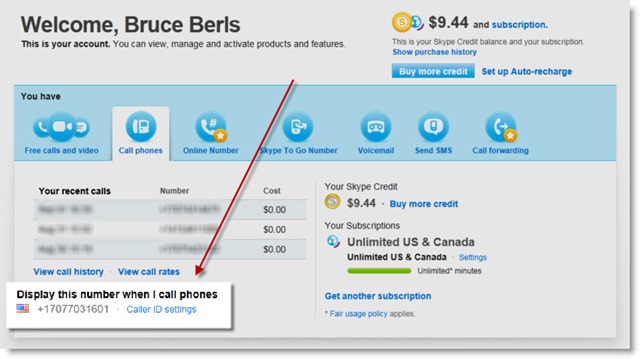
Previously:
Understanding Google Voice
Fully Committed to Google Voice – Part 1
Google Voice Interlude – Background About Voice And Data
Fully Committed to Google Voice – Part 2
Skype is best known for its program that runs on a computer to call other Skype users for free anywhere in the world, but Skype is able to do several other things now – things you’ll recognize from what I’ve been writing about Google Voice.
Skype is built on the same technology to carry your voice over an Internet data connection for as much of the journey as possible. A Skype call to another Skype user travels over the Internet the whole way. When Skype is used to interact with landlines and mobile phones, the call stays on the Internet until it is routed into the telco circuits at the last minute.
- You can use Skype to make phone calls to landlines and mobile phones very inexpensively – a few dollars per month for unlimited calls in the US and Canada, a few cents per minute for international calls.
- Skype can assign a phone number to you that you can use to receive calls placed from landlines and mobile phones – again, an inexpensive monthly subscription.
- You can install a Skype app on iPhones and Android phones to make and receive calls, although just as with Google Voice, there is a confusing path to discover what does and doesn’t work. Will the calls travel over the carriers’ data networks? Will they work over an 802.11 wireless network? Will you use your voice minutes when you place a Skype call? The answers will change from carrier to carrier, device to device, month to month.
Here’s an overbroad but useful generalization to sum things up:
- Google Voice is well suited to help you receive calls, by giving you a new number and helping you route your incoming calls very efficiently to the phones in your life.
- Google Voice can be used to make calls but it’s rough around the edges.
- Skype is well suited to help you make calls, especially for international calls and calls to other Skype users. The cost savings on international calls can be dramatic and will quickly repay the time it takes to figure out how it works.
- Skype can be used to receive calls but it’s rarely used just for that purpose. Most people don’t have a reason to switch to a Skype number when they can more easily use their cell phone or landline numbers.
- Almost no one needs both services. Pick one. Learn it. Wrestle with it. Make it work for you.
I’ve got a Plantronics USB headset plugged into my office computer for Skype calls. It looks just like the ubiquitous Plantronics CS-55 headset plugged into my office landline next to it, and provides the same call quality and very long range for walking around the office.
I also just invested in a Logitech C910 webcam for video calls with Skype. It’s the latest and greatest webcam technology. If you happen to get one, two things to know:
- As with many USB devices, it will work perfectly with Windows 7 if it is simply plugged in, with no software installed from the Logitech CD. Bypassing the bloated Logitech disk means I don’t have the huge software suite that would assist me in turning my webcam picture into an animated shark. Oddly, I felt that it was unnecessary for me to place a call as an animated shark. No imagination, I guess.
- The Logitech C910 is capable of 1080p HD video but Skype is not yet able to deliver that quality video. The Skype 5 beta runs at 720p, which is actually quite good compared to previous generations of webcams.
There’s one more technical note that allowed me to fulfill my goal of having you see only my Google Voice number when I call you. I purchased a Skype subscription to make unlimited calls with Skype to US phones. Skype allows a non-Skype phone number to be shown in the caller ID for outgoing calls.
It can be set up for any phone where you can receive a text message. That requirement was part of what started this long project, because it was only recently that a text message from Skype to a Google Voice number would appear on an Android phone. Once that was sorted out, it began to work: I call you from Skype and you see my Google Voice number.
Throughout all of this setup and experimenting, one thing has been constant, one reliable part of the experience has turned up over and over, every day, every week, month after month, using two different headsets, two different office phones, three different models of cell phone, with connections carried over Comcast circuits and Verizon circuits and the Internet. The part that never changes:
“Hello? Hello? Are you still there? You cut out for a second. Hang on. Is that better? Let me call you back on the other line. What? Hello?”



Trackbacks/Pingbacks